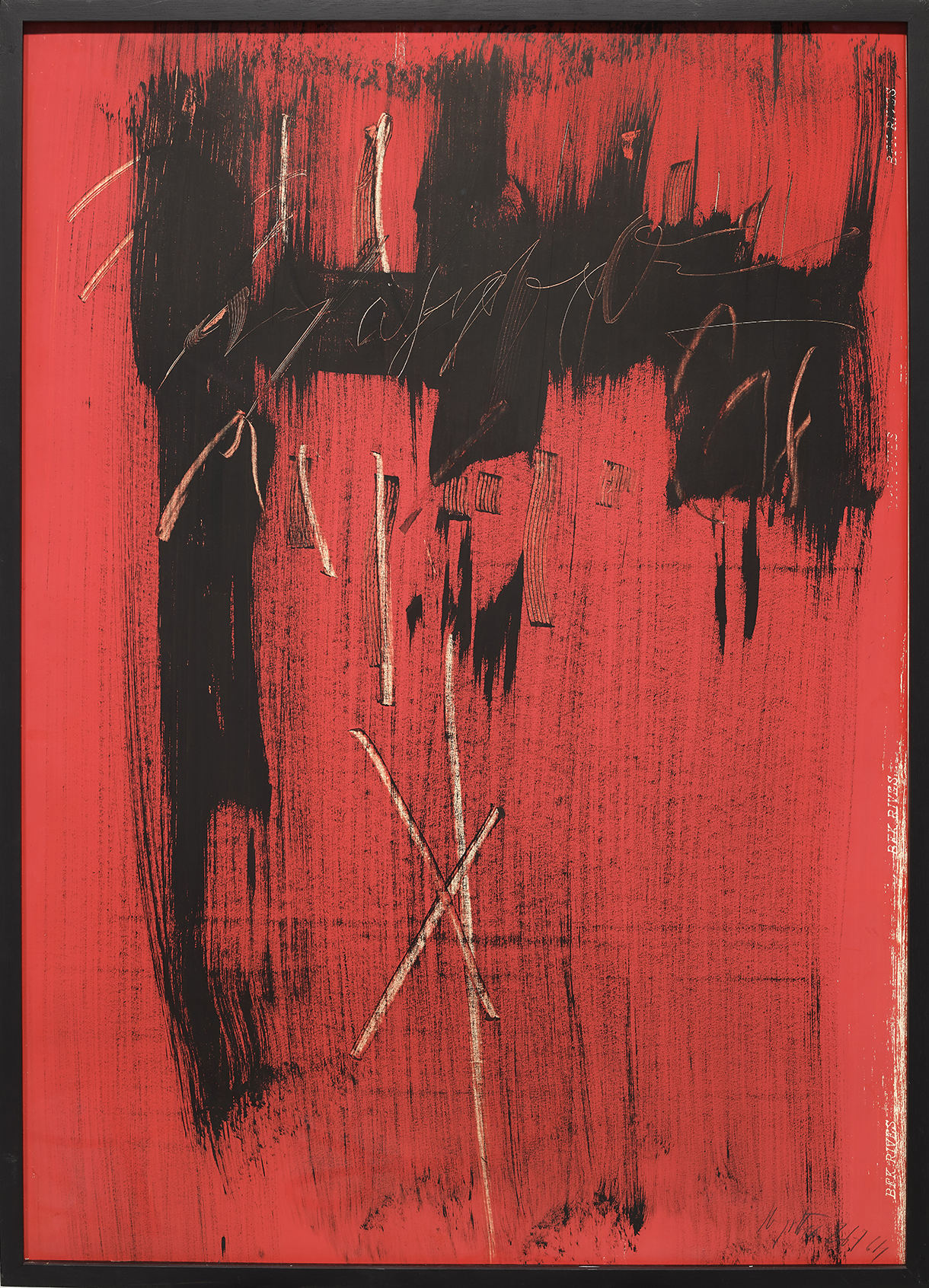Jean DegottexSuite Rouge VII
1964
Gouache on paper
Signed and dated lower right
41.34 x 29.53 x 8.86 in ( 105 x 75 x 22.5 cm )ZoomInquiry - Suite Rouge VII, 1964
Certificat
Provenance
Private Collection, Belgium
Artwork's description
In 1964, after a year of inactivity following the death of his daughter, Jean Degottex resumed the series of Écritures. The colour red dominates, this hue holds significant importance in the artist's work. It evokes passion, warmth, energy, but also anger or introspection.
Once the background is applied, the artist overlays India ink on the paper, which is laid on the floor, using a broad brush. The material is thin, and the calligraphy is applied with a light stroke. The writing floats in a space of air density. It is executed with a spontaneous and lively gesture, imbuing a sense of movement. The gesture seems restored to its purity.
A symbol has also been drawn: a cross. A symbol that can be found in the early paintings that follow the death of his daughter. Initially a sign of rebellion and denial, the cross gradually becomes integrated into his painting and titles.
This work is a remarkable example of Jean Degottex's quest to express the inexpressible, to allow the invisible to shine through, and to translate his inner world.
Artist's biography
Jean Degottex, born on February 25, 1918, in Sathonay-Camp, into a modest family, spent his childhood in Lyon. At the age of fifteen, he moved to Paris with his parents, leaving school to enter the workforce. It was in the French capital that he frequented libertarian circles and took part in drawing and painting sessions at free academies, notably the Académie de la Grande Chaumière. It was also during his military service in Tunisia and Algeria, from 1939 to 1941, that Degottex painted his first canvases, characterized by a fauvist and figurative inspiration.
Degottex's artistic career took a decisive turn in 1941 when he decided to devote himself entirely to painting. He exhibited at the Salon des moins de Trente Ans. In 1946, he married Marie-Rose (Mirose) Patrix, sister of the artist Michel Patrix, and their daughter Frédérique was born in February 1947.
From 1948 onwards, Degottex embraced abstraction definitively, developing a gestural painting that placed him among the leading figures of lyrical abstraction. In 1949, he exhibited for the first time at Denise René's gallery, renowned for its support of abstract avant-gardes, and later at the Galerie de Beaune. That same year, he began a relationship with Renée Beslon, a poet, visual artist, and art critic, who would remain his companion until his death. In 1951, he was awarded the prestigious Kandinsky Prize. From 1954, his works showed an increasingly radical abstract gesturality.
In 1955, Degottex joined the Kléber gallery, led by Jean Fournier, where he maintained sometimes tumultuous artistic relationships with Simon Hantaï and Georges Mathieu, and formed friendships with the poet Bernard Heidsieck, as well as the artists Françoise Janicot, Jean Dupuy, and Paul Armand Gette. In 1959, he joined the Galerie internationale d'art contemporain directed by Maurice d'Arquian.
The period from 1956 to 1963 was particularly prolific for Degottex, marked by the creation of numerous large-scale works, often organized in series such as Ashkénazi (1957), Serto (1957), Hagakure (1957), the 18 Vides (1959), the Roses (1960), the Alliances (1960), the 7 Métasignes (1961), and Jshet (1962). These works were characterized by a fusion of prolonged meditation and spontaneous execution.
The tragic loss of his daughter Frédérique at the age of 16 in 1963 plunged Degottex into a period of despair and inactivity. However, he resumed his work with the series Écritures, followed by the Rose noire (1964), Suite obscure (1964), Métasphère (1966), Etc (1964-1967), and Horsphères (1967). From 1966, Degottex spent long periods working in Gordes, in the Vaucluse.
In 1968, he actively participated in the graphic creation movement that accompanied the events of May 68. In 1969, he collaborated with the architect Jean Daladier on the design of dome houses in Saint-Julien-du-Sault and exhibited at the Musée d'art moderne in Paris.
From 1972 to 1976, Degottex organized several solo exhibitions at the Galerie Germain and returned to exhibit at Jean Fournier's gallery. He explored new artistic techniques, working on paper with tears and collages, and using the "report" technique by folding, as evidenced by the series Lignes-Report (1978) and Plis-Report (1978).
In 1979, for a solo exhibition at the Abbaye de Sénanque, he created the Déplis series, which included numerous large Déplis-Bleu. In 1981, he received the Grand Prix national de peinture. In 1982, he joined the Galerie de France, directed by Catherine Thieck, and created the Grilles-Collors, Oblicollors, and Diacollors series. His last major works, Lignes-Bois (1985) and Contre-Lignes Bois (1986), were characterized by white, gray, and blue-gray tones.
Jean Degottex died in Paris on December 9, 1988, leaving behind an artistic legacy marked by innovation and an unceasing quest for new forms of expression.
